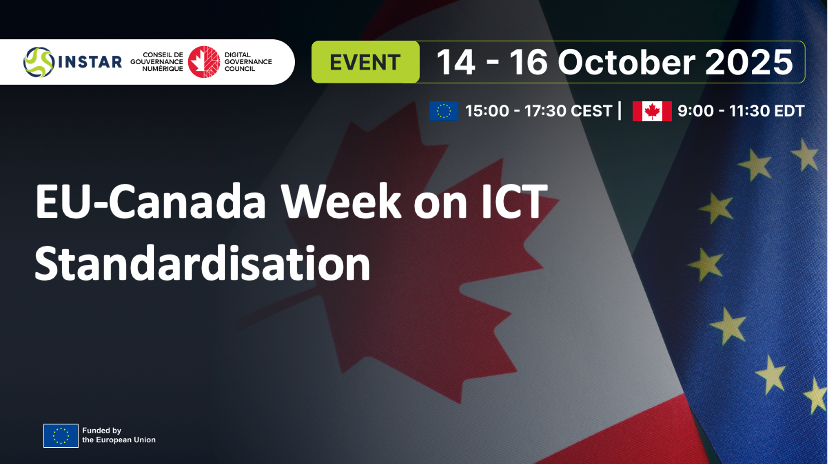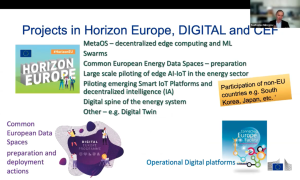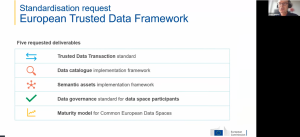Building a trusted digital future: the EU-Canada digital partnership week on ICT standardisation

A transatlantic vision for digital cooperation
How do two like-minded partners on opposite sides of the Atlantic shape the digital standards that define our future?
That question framed the EU-Canada digital partnership week on ICT standardisation, where policymakers, researchers, and industry leaders came together to turn shared values into shared digital infrastructure.
Over three days, participants explored three interconnected themes: Cloud-Edge-IoT (CEI), Data and Data Spaces, and Quantum & Post-Quantum Cryptography (PQC). The message that emerged was clear: technical alignment is not enough, real interoperability requires trust, governance, and collaboration.
This spirit of cooperation sits at the heart of the EU-Canada Digital Partnership, launched to strengthen technological sovereignty, competitiveness, and global digital governance built on democratic principles.
From standards to interoperability: A shift in thinking
A recurring insight across sessions was that conformity to standards doesn’t automatically guarantee interoperability. Many Standards Developing Organisations (SDOs) still operate in silos. There’s often no governance mechanism or negotiation process allowing two committees within the same SDO to coordinate when their domains overlap.
This internal fragmentation is compounded by a larger problem: even when standards are agreed upon, there’s no shared understanding of how to apply them. As Keith Jansa, CEO of the Digital Governance Council, noted, “the real challenge isn’t the lack of standards, it’s the lack of interoperability.” He argues that without shared testbeds to validate implementation, consensus on paper doesn’t translate to compatibility in the real world. The next phase of standardisation isn’t about more technical standards, it’s about how they work together.

True interoperability depends on more than technical compliance. It requires:
- Cross-layer governance standards that define how systems interact in practice.
- Interoperability profiles and testbeds to validate systems in real-world conditions.
Both the EU and Canada recognised this as a priority for joint action, aiming to close the gap between specification and implementation.
Cloud-Edge-IoT: Building the backbone of a connected world
On Day 1, discussions turned to the future digital infrastructure that will power everything from smart cities to precision agriculture. Svetoslav Mihaylov (European Commission) outlined how Europe is investing in open, interoperable CEI ecosystems through different projects.

Kurtis McBride of Miovision offered a vivid example from traffic management, help the city to understand and automise traffic flow through urban intersection networks to create a safer, smarter and internationally scalable model. “Standardisation is an enabler of innovation, not a constraint”, he highlighted that many intersection control systems still rely on standards written decades ago and Canada is helping modernise these systems through new ISO work designed to be universally applicable.
Data Spaces: Trust as the foundation of collaboration
Day 2 focused on how the EU and Canada can create trusted frameworks for data sharing that respect ethics, privacy and governance across borders.
The European perspective emphasised that there is no single, monolithic data space. Instead, Europe is developing numerous domain-specific spaces (e.g., health, mobility) with unique needs. The European Commission has mandated the development of standards to ensure interoperability within and across these spaces, in compliance with Article 33 of the Data Act. Experts stressed that EU regulations set principles but require testable standards to ensure consistent technical implementation and avoid divergent legal interpretations. Coen Janssen (European Commission) described the European Trusted Data Framework, a cornerstone of the EU’s Data Act.
This framework includes five key deliverables designed to make data discoverable, interoperable and secure.

Eric Rancourt (Statistics Canada) presented national frameworks such as the “Gather-Guard-Grow-Give” data lifecycle model (which has been adopted in Estonia) and the Data Ethics Framework, prioritising data quality to ensure that AI systems and policies are built on accurate information. A key takeaway was that interoperability must be embedded from the design phase to create secure and scalable systems.
Both sides agreed that data interoperability and mutual recognition of standards should be at the centre of future EU-Canada collaboration, supported by public-private partnerships and practical pilot projects.
Quantum and PQC: Preparing for the post-Quantum era
The final day addressed one of the most urgent global challenges: the quantum threat to today’s cryptography. As quantum computing matures, it makes migration to quantum-secure solutions both inevitable and time-sensitive.
The immediate strategic imperative is the urgent fix: developing and deploying Post-Quantum Cryptography (PQC). Simultaneously, the long-term vision involves building the quantum-native infrastructure of tomorrow. This track focuses on technologies like Quantum Key Distribution (QKD).
Experts agreed that the migration to quantum-safe cryptography cannot wait, as the real challenge lies in upgrading millions of legacy systems. Standards were framed as the essential bridge between scientific innovation and market adoption. The dialogue emphasised that quantum standardisation must be guided by democratic values, openness, and ethical responsibility to build a trusted global ecosystem.
A peek into the challenges of Quantum progress
The European-Canadian research project “Hyperspace” from Fabian Steinlechner (Fraunhofer IOF) and Thomas Jennewein (University of Waterloo) offers a powerful lesson in the fundamental challenges of quantum standardisation. The HyperSpace initiative, presented by Fabian Steinlechner (Fraunhofer IOF) and Thomas Jennewein (University of Waterloo), offers a powerful illustration of the real challenges behind quantum progress. Before any technical work could advance, the team had to recognise that experts from different communities often use different terminologies, metrics, and reference models. This meant aligning foundational concepts: how performance should be measured? What parameters matter? How results should be compared?

HyperSpace is a perfect microcosm of the entire standardisation effort. It shows that the deepest challenges are not purely technical, but human: establishing shared definitions, shared expectations and a shared language across diverse disciplines. Only then can truly global, interoperable quantum infrastructure be built.
What comes next? A shared path forward
The EU-Canada Digital Partnership Week was more than a conference, it was a call to action.
By combining their technical expertise, regulatory experience, and commitment to openness, the EU and Canada are laying the groundwork for a trusted, interoperable, and democratic digital ecosystem that others can build upon.

